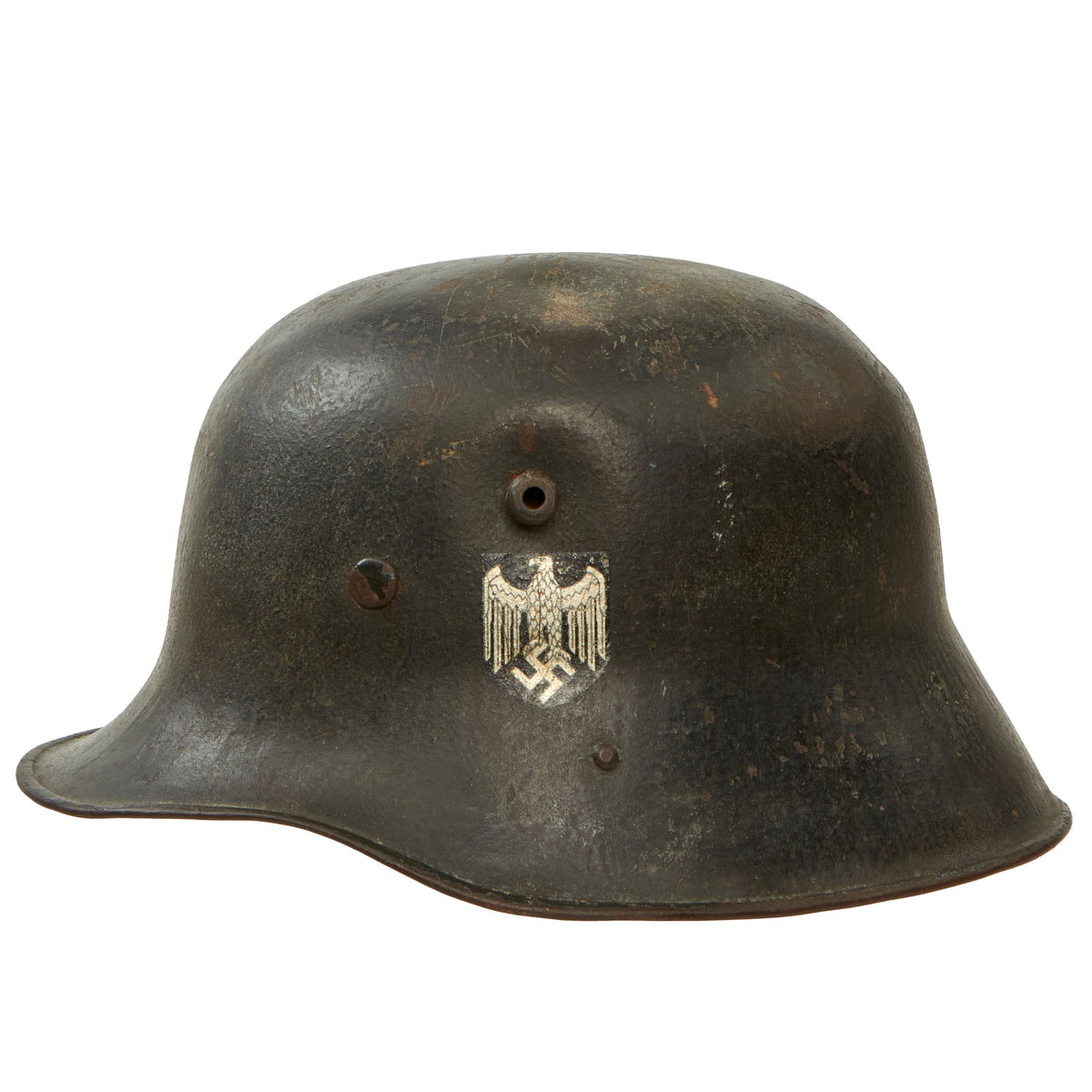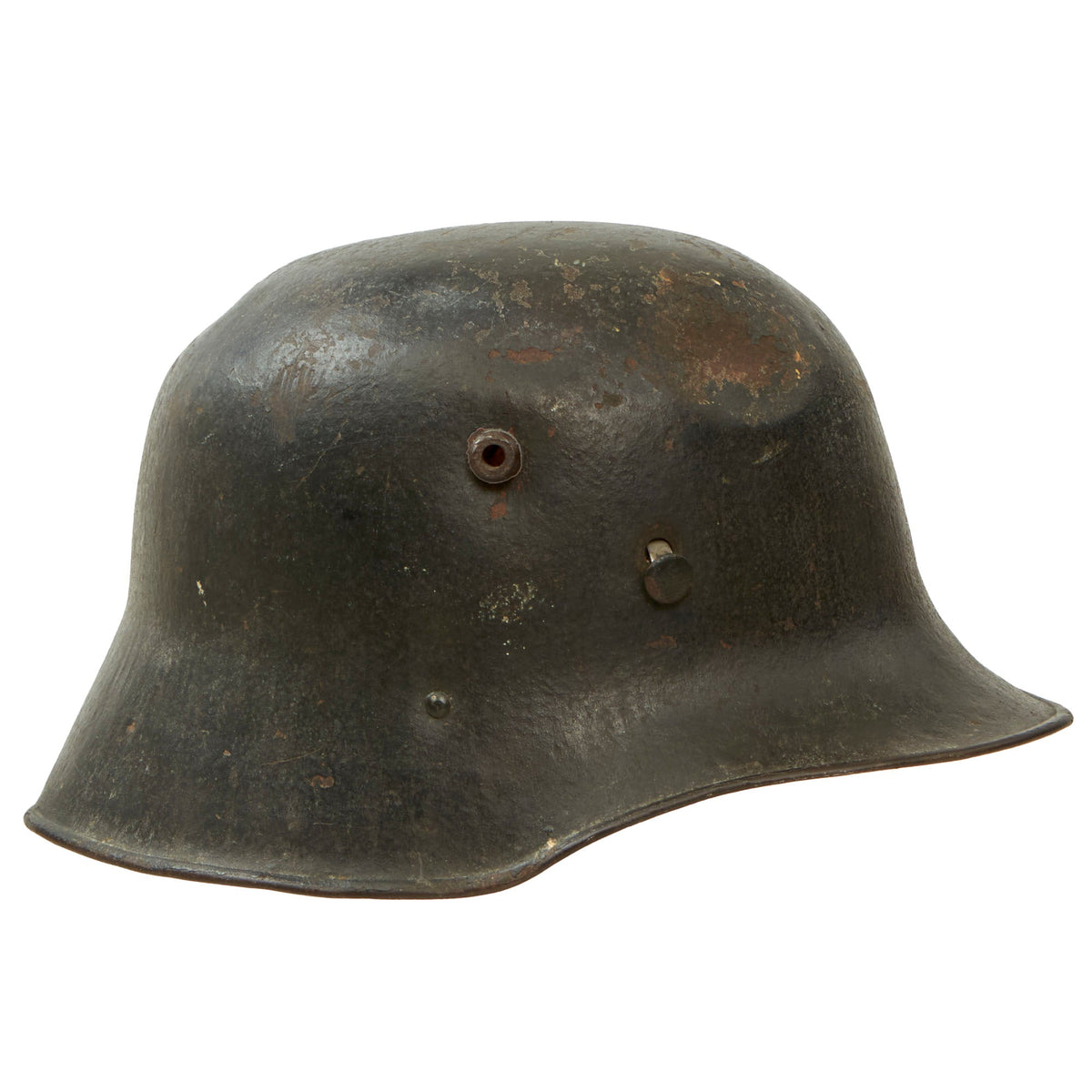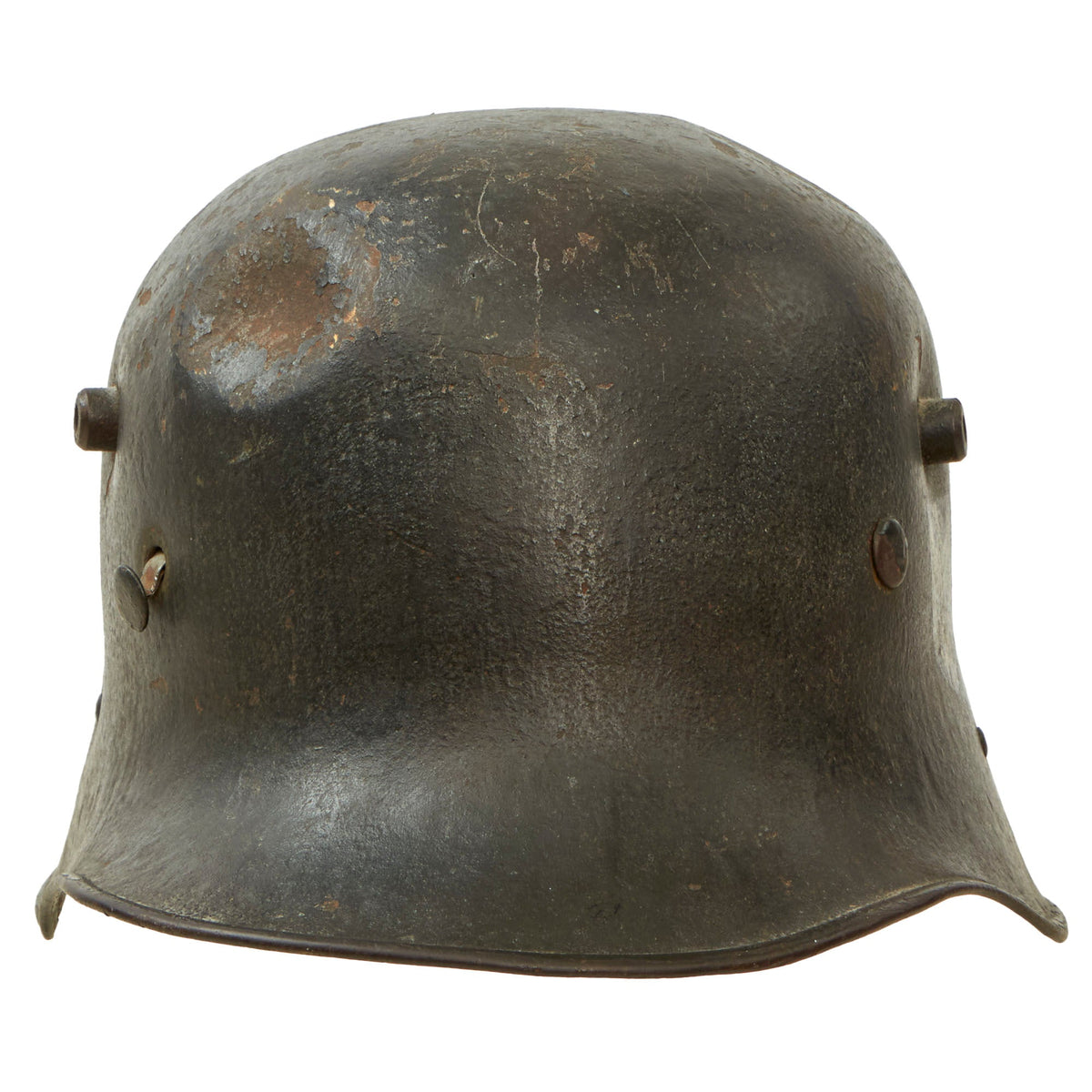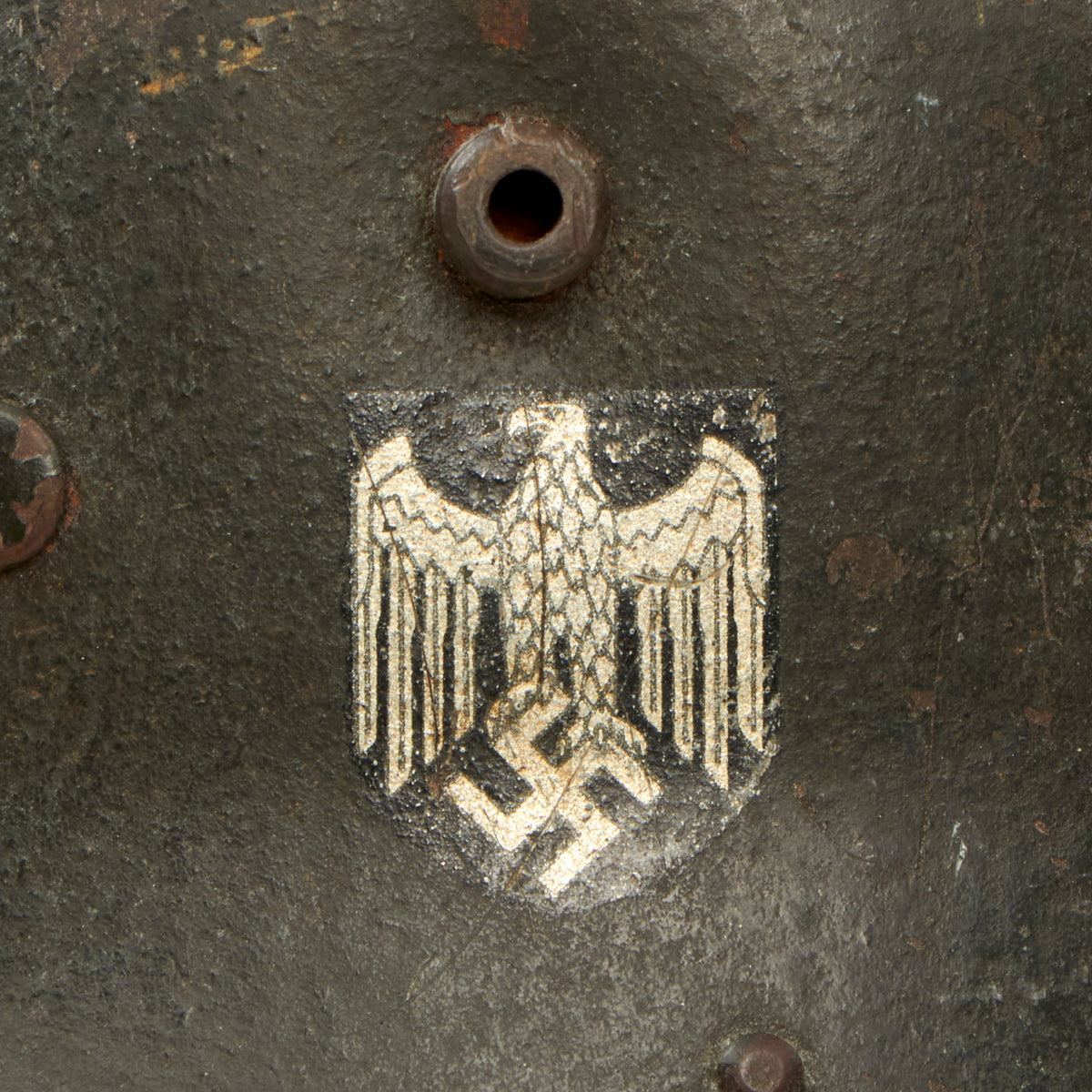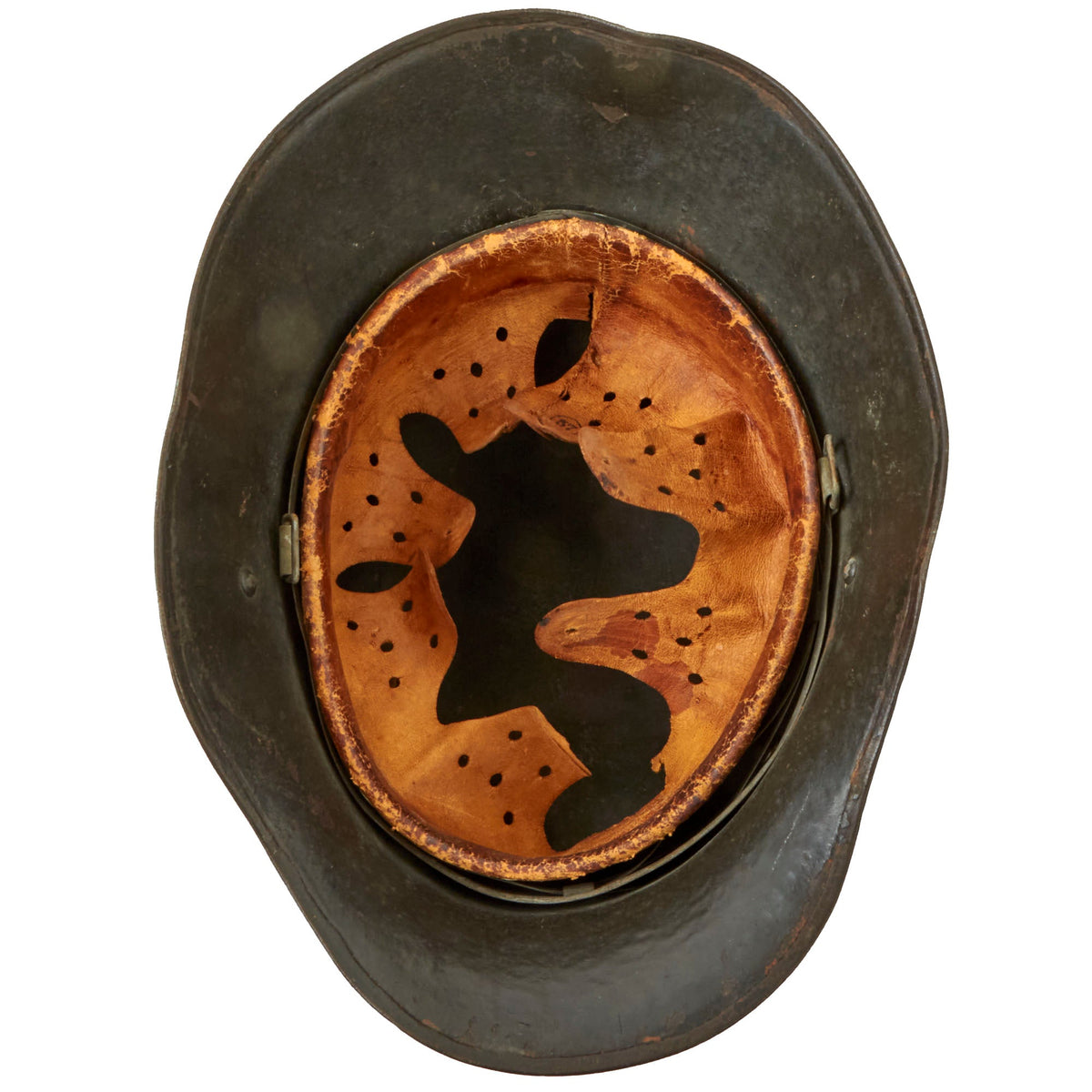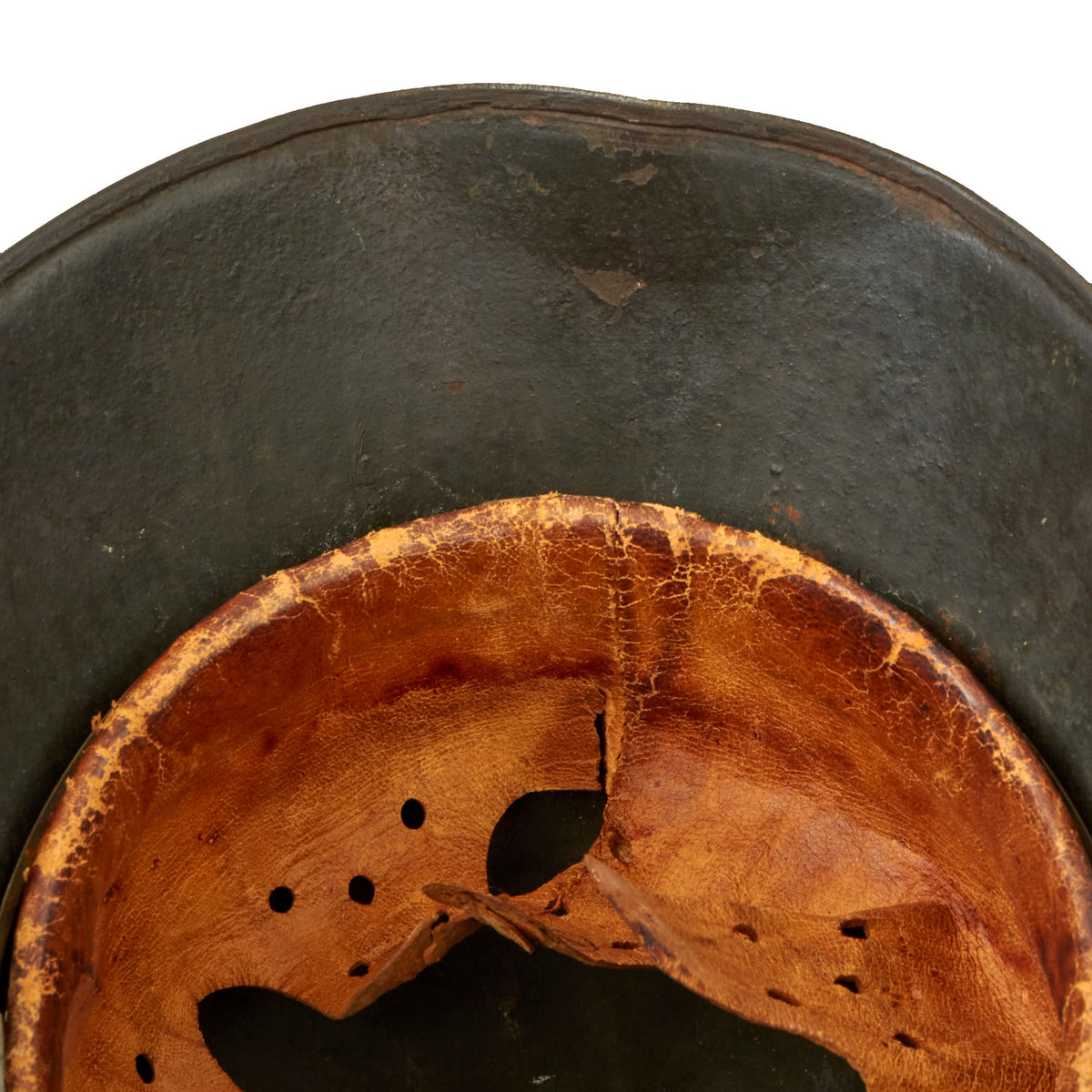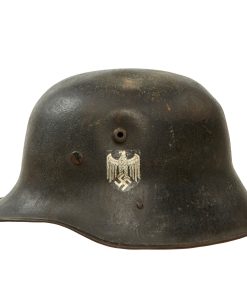Original German WWII Austrian M17 Battle Damaged Transitional Heer Army Single Decal Helmet with 57cm Liner Original Items
$ 695,00 $ 208,50
Original Item: Only One Available. Austria-Hungary purchased about 416,000 German helmets from November 1916 until the end of the war, and also began its own licensed production starting in May 1917. Around a million Stahlhelm of all variants were issued until the end of the war. The Austrian M17 helmet was similar to the German M16 but was colored golden-brown (known as Isonzo-braun), had a cloth chinstrap and had the chinstrap rivet located higher up on the steel shell. From May 1917 till the end of World War I 534,013 were produced, many of which were manufactured at the Krupp plant in Berndorf, Lower Austria.
This is a very nice “Battle Damaged” example of a WWI M17 Austro-Hungarian Helmet that was converted for use by the Third Reich in the 1930s before the issue of the M1935 helmet. It then looks to have seen long service into the 1940s, and definitely suffered some large dents, as well as some bends in the rear skirt. It even has the vent studs somewhat “pushed in”, so this was a helmet that possibly got hit by a car or was damaged under rubble. It has a fantastic look that is impossible to duplicate!
The original “Isonzo braun” paint was removed from the shell, and most likely it was originally painted with WWII early war “Apfel-grün” (Apple Green) paint. However the helmet is currently painted inside and out with later war Panzergrau (Armor Gray) paint, and we can see no trace of the Apple green. It may be possible that this helmet was not put back into service during the 1930s, but instead towards the end of the war. Definitely some great research potential here!
The shell still retains much of the exterior paint, however it definitely shows wear and scraping on the top, with more missing around the rim. The large dents also are missing some paint, which probably flaked off when they occurred. As with most mid to late war helmets, the shell has a single Heer Army silver eagle decal on the left side, which is retained at about 90%, with light overall wear. The original chin strap attachment bales were removed, as was often done when the Austrian helmets were being reconfigured by the Germans, leaving only the rivets.
There is no maker or size marking stamped on the shell, however this is typical for Austro-Hungarian M17 helmets, as many of the makers used only ink stamps, easily painted over. It does however have a clear 6 8 0> rolling mill lot number stamped onto the inside of the dome. We measured the outside of this helmet, and we are fairly certain that it is in size 66cm. This is a nice large size that would usually accommodate size 58 to 59 hat sizes, which is 7 1/4 to 7 3/8 in U.S. sizes. The helmet still has the correct short vent hole lugs without steps, for attachment of a “stirnpanzer” helmet plate. Smaller sized helmets would have a step, but this does not, confirming its larger size.
All three liner retaining pins are intact, with exterior paint partially retained on all, with some wear and oxidation from service. The rear pin however looks to be a post war replacement. The interior of the helmet still has the original M31 liner with the leather still relatively supple, however one of the eight “fingers” has torn away and the top tie is missing. There is staining and a bit of flaking around the rim, and there is a size 57 in a circle stamped on one of the rear fingers. There is no size marking that we are able to see on the outside of the galvanized steel band, so it may be a custom size for a different size shell than usual. The right side displays the full manufacture information, as well as a date:
B. & C.
LITZMANNSTADT
1943
This liner was made by Biedermann & Czarnikow, a German company who moved operations to Łódź in occupied Poland to take advantage of the slave labor in the ghetto located there. NSDAP authorities renamed Łódź to Litzmannstadt in honor of the German General Karl Litzmann who had captured the city in the previous World War. The chin strap is completely missing.
This is a very nice “battle damaged” example of a WWII reissued Austrian M17 helmet, one of the few that we have been able to offer. Ready to fill a spot in your helmet collection!
The first “modern” steel helmets were introduced by the French army in early 1915 and were shortly followed by the British army later that year. With plans on the drawing board, experimental helmets in the field, (“Gaede” helmet), and some captured French and British helmets the German army began tests for their own steel helmet at the Kummersdorf Proving Grounds in November, and in the field in December 1915. An acceptable pattern was developed and approved and production began at Eisen-und Hüttenwerke, AG Thale/Harz, in the spring of 1916. These first modern M16 helmets evolved into the M18 helmets by the end of WWI. At the end of WWI it is estimated that Germany had produced about 8,500,000 steel helmets. As a result of the restrictions placed on the German’s by the Treaty of Versailles, which dictated a standing army of only 100,000 personnel, there was an abundant surplus of these helmets, and though they saw widespread use by Freikorps personnel, there was still a stockpile controlled by the Reichswehr.
These excess helmets underwent minor modifications in 1923 with the addition of provincial identifying shield decals and in 1931 with the development of a new chinstrap and liner system. Although helmet development was ongoing when AH came to power in 1933, the M16 and M18 helmets were still the main headgear worn by the Reichswehr. The helmets remained the same until March 1933 when the provincial shields were discontinued in favor of the national tri-color shield. In 1934 the national eagle shield was introduced, and both the tri-color and eagle shields were applied to the helmets. After the development of the new M35 helmet, the WWI helmets were still issued to second line and training troops well into WWII. The Austrian M16 was almost identical to the German version with the positioning of the chinstrap liner rivets being the most readily identifiable difference.
Austro-Hungarian Helmets
The Central Powers of Austria-Hungary used, manufactured and commissioned, variations of the World War One German Stahlhelm M16 design. The Austrian M1917 helmet was similar to the German M1916, but had a few variations including the chinstrap, chinstrap rivets located higher up on the steel shell and variations in locations of markings among others.
Early Austrian helmets were supplied by Germany, the first shells supplied as the chinstrap rivets were mounted in a lower position. The Austrians fitted their own chinstrap bales, chinstraps and liner and painted them in Austrian Isonzo braun. These modifications were carried out with German machinery at the “Adolf Westen di Cilli factory, which is now Celije, in Slovenia.
Later Austria-Hungary made their own helmets, and eventually developed a model similar to the German M18, but it did not see wide use before the end of the war, just as with German’s M18. Both were an an important stepping stone towards the German helmets of WWII, which moved to chin straps attached to the liner, not the shell.
Austro-Hungarian WWI Helmets Makers-
There are only 9 known factories that produced helmets during WWI for the KUK. Unlike the Germans the Austrian pattern helmet are often found without factory stamps and heating lot codes. When the heating lot codes are present it is often on the outer top dome of the helmet instead of the inside. The following is a table of Manufactures codes of helmets produced by the Austrians. Several of these makers did not stamp the code into the shell of the helmet but rather marked them with an ink stamp. Therefore many Austrian shells will be encountered today that seem to have no maker mark as the ink stamp has worn off, but most will have rolling mill codes.
Maker Name Factory Location Maker code Sizes Model
A. Westen Cilli Celie, Slovenia AW 64 M17
Brüder Gottlieb u. Brauchbar Brunn BGB 66 M17
C. A. Scholtz,Mateocz Sloeakei CAS 66 M17
Berndorfer Metal-Warenfabrik Berndorf, Austria “Bear” logo 66,64
Bruder Lapp, Rottenman u. Warcholowsky Unknown ? M17
Nadrag,Transilvania Transylvania Unknown ? M17
Resicka, Transylvania Transylvania Unknown ? M17
Bleckmann & Poldihutte Klando Boemia Unknown x Stirnpanzer
Gebruder Bohler & Co., Kapfen Austria, Stiria GB “Star” 66 M17
Rolling Mills Marker Code
Ludwikow L
Bleckmann B
Poldi P
Fast Shipping with Professional Packaging
Thanks to our longstanding association with UPS FedEx DHL, and other major international carriers, we are able to provide a range of shipping options. Our warehouse staff is expertly trained and will wrap your products according to our exact and precise specifications. Prior to shipping, your goods will be thoroughly examined and securely secured. We ship to thousands clients each day across multiple countries. This shows how we're dedicated to be the largest retailer on the internet. Warehouses and distribution centres can be located throughout Europe as well as the USA.
Note: Orders with more than one item will be assigned a processing date depending on the item.
Before shipping before shipping, we'll conduct a thorough inspection of the items you have ordered. Today, the majority of orders will be delivered within 48 hours. The delivery time will be between 3-7 days.
Returns
The stock is dynamic and we cannot completely manage it because multiple stakeholders are involved, including our factory and warehouse. So the actual stock may alter at any time. It's possible that you may not receive your order once the order has been made.
Our policy is valid for a period of 30 days. If you don't receive the product within 30 days, we are not able to issue a refund or an exchange.
You can only return an item if it is unused and in the same state as the day you received it. You must have the item in its original packaging.
Related products
Uncategorized
Uncategorized
Band of Brothers ORIGINAL GERMAN WWII Le. F.H. 18 10.5cm ARTILLERY PIECE Original Items
Uncategorized
Uncategorized
Uncategorized
Uncategorized
Uncategorized
Uncategorized
Armored Burgonet Helmet & Polearm from Scottish Castle Leith Hall Circa 1700 Original Items
Uncategorized
Uncategorized
Uncategorized
Uncategorized
Angolan Rebel 1970s era 60mm Inert Display Mortar from Angolan Civil War Original Items
Uncategorized
Uncategorized
Australian WWII Owen MK1 Machine Carbine SMG Custom Fabricated Replica with Sling Original Items
Uncategorized
Armoured Fighting Vehicles of the World: AFVs of World War One (Hardcover Book) New Made Items
Uncategorized
